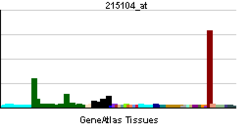- NRIP2
-
Nuclear receptor interacting protein 2 Identifiers Symbols NRIP2; DKFZP761G1913 External IDs MGI: 1891884 HomoloGene: 11023 GeneCards: NRIP2 Gene Gene Ontology Molecular function • aspartic-type endopeptidase activity Cellular component • nucleus
• cytoplasmBiological process • negative regulation of transcription from RNA polymerase II promoter
• regulation of transcription, DNA-dependent
• proteolysisSources: Amigo / QuickGO RNA expression pattern 
More reference expression data Orthologs Species Human Mouse Entrez 83714 60345 Ensembl ENSG00000053702 ENSMUSG00000001520 UniProt Q9BQI9 Q52KR0 RefSeq (mRNA) NM_031474 NM_021717 RefSeq (protein) NP_113662 NP_068363 Location (UCSC) Chr 12:
2.93 – 2.94 MbChr 6:
128.35 – 128.36 MbPubMed search [1] [2] Nuclear receptor-interacting protein 2 is a protein that in humans is encoded by the NRIP2 gene.[1][2]
References
- ^ Wiemann S, Weil B, Wellenreuther R, Gassenhuber J, Glassl S, Ansorge W, Bocher M, Blocker H, Bauersachs S, Blum H, Lauber J, Dusterhoft A, Beyer A, Kohrer K, Strack N, Mewes HW, Ottenwalder B, Obermaier B, Tampe J, Heubner D, Wambutt R, Korn B, Klein M, Poustka A (Mar 2001). "Toward a Catalog of Human Genes and Proteins: Sequencing and Analysis of 500 Novel Complete Protein Coding Human cDNAs". Genome Res 11 (3): 422–35. doi:10.1101/gr.GR1547R. PMC 311072. PMID 11230166. http://www.pubmedcentral.nih.gov/articlerender.fcgi?tool=pmcentrez&artid=311072.
- ^ "Entrez Gene: NRIP2 nuclear receptor interacting protein 2". http://www.ncbi.nlm.nih.gov/sites/entrez?Db=gene&Cmd=ShowDetailView&TermToSearch=83714.
Further reading
- Greiner EF, Kirfel J, Greschik H, et al. (2000). "Differential ligand-dependent protein–protein interactions between nuclear receptors and a neuronal-specific cofactor". Proc. Natl. Acad. Sci. U.S.A. 97 (13): 7160–5. doi:10.1073/pnas.97.13.7160. PMC 16516. PMID 10860982. http://www.pubmedcentral.nih.gov/articlerender.fcgi?tool=pmcentrez&artid=16516.
- Hartley JL, Temple GF, Brasch MA (2001). "DNA Cloning Using In Vitro Site-Specific Recombination". Genome Res. 10 (11): 1788–95. doi:10.1101/gr.143000. PMC 310948. PMID 11076863. http://www.pubmedcentral.nih.gov/articlerender.fcgi?tool=pmcentrez&artid=310948.
- Simpson JC, Wellenreuther R, Poustka A, et al. (2001). "Systematic subcellular localization of novel proteins identified by large-scale cDNA sequencing". EMBO Rep. 1 (3): 287–92. doi:10.1093/embo-reports/kvd058. PMC 1083732. PMID 11256614. http://www.pubmedcentral.nih.gov/articlerender.fcgi?tool=pmcentrez&artid=1083732.
- Strausberg RL, Feingold EA, Grouse LH, et al. (2003). "Generation and initial analysis of more than 15,000 full-length human and mouse cDNA sequences". Proc. Natl. Acad. Sci. U.S.A. 99 (26): 16899–903. doi:10.1073/pnas.242603899. PMC 139241. PMID 12477932. http://www.pubmedcentral.nih.gov/articlerender.fcgi?tool=pmcentrez&artid=139241.
- Ota T, Suzuki Y, Nishikawa T, et al. (2004). "Complete sequencing and characterization of 21,243 full-length human cDNAs". Nat. Genet. 36 (1): 40–5. doi:10.1038/ng1285. PMID 14702039.
- Gerhard DS, Wagner L, Feingold EA, et al. (2004). "The Status, Quality, and Expansion of the NIH Full-Length cDNA Project: The Mammalian Gene Collection (MGC)". Genome Res. 14 (10B): 2121–7. doi:10.1101/gr.2596504. PMC 528928. PMID 15489334. http://www.pubmedcentral.nih.gov/articlerender.fcgi?tool=pmcentrez&artid=528928.
- Wiemann S, Arlt D, Huber W, et al. (2004). "From ORFeome to Biology: A Functional Genomics Pipeline". Genome Res. 14 (10B): 2136–44. doi:10.1101/gr.2576704. PMC 528930. PMID 15489336. http://www.pubmedcentral.nih.gov/articlerender.fcgi?tool=pmcentrez&artid=528930.
- Mehrle A, Rosenfelder H, Schupp I, et al. (2006). "The LIFEdb database in 2006". Nucleic Acids Res. 34 (Database issue): D415–8. doi:10.1093/nar/gkj139. PMC 1347501. PMID 16381901. http://www.pubmedcentral.nih.gov/articlerender.fcgi?tool=pmcentrez&artid=1347501.
Categories:- Human proteins
- Chromosome 12 gene stubs
Wikimedia Foundation. 2010.
